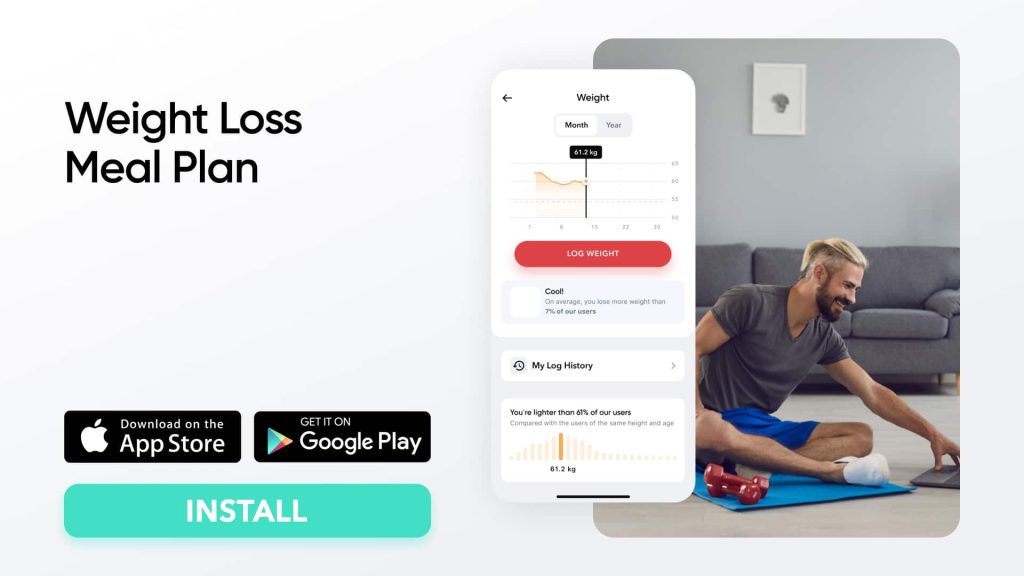At some point in our lives, we have all tried or thought about going on the “losing weight” journey. The term has been used around quite a lot so that we instinctively assume to know what it’s about. But do we really know what happens in our bodies when we lose weight?
You see, losing weight involves both your fat and muscle mass. Each of the two masses plays a critical role in the equation. However, what you want to drop is your fat mass. Why? We answer that by looking at how fats behave in your body.
How Is Fat Stored In The Body?
When you take that piece of chicken or any other food containing fats, what happens to it once ingested? How does it end up getting stored in your body in the first place? Here’s what you need to know about fat storage in the body.
Fats are among the three major macros alongside carbs and protein. These three macros are essential nutrients that supply your body with caloric energy. Carbs are indeed the most preferred source of energy for your body. However, fats are the most energy-dense among the three (6).
Fats contain about 9kcal per gram, twice as much as proteins and carbs, which give only 4kcal (6). So if you’ve been wondering why fat is an ideal storage form of energy in the body, you have your answer.
Whenever you eat fats, a series of processes triggers metabolism, which is then used to break down fats. Ideally, the fat molecules are transformed into energy that is used to fuel your body. How does that happen?
Triglycerides, or simply fats, are broken down into fatty acids and glycerol. These two resultant products are absorbed by your kidneys, liver, and muscle tissues. The byproducts of this chemical process produce heat which maintains your body temperature. On the other hand, waste products like carbon dioxide and water are also released.
Your body does not dispose of excess fats, instead, it stores them throughout the body in fat cells known as adipocytes (5). So if you’ve been wondering what causes fat storage in the body, the answer is when it’s in excess. There’s only so much that your body can use at a go.
What about glucose? Why is glucose necessary for energy storage in body fat? First off, glucose is a simple sugar that provides energy for all cellular functions. Whenever your body digests food, glucose is released into your blood.
The pancreas then responds by producing insulin. Insulin then instructs your muscles and fat cells to absorb and use up glucose. Simply put, glucose provides your cells with a source of energy. However, when it is in excess, your body converts it to fat for long-term storage.
Remember, fat is technically only stored in one place in your body- in your adipocytes (5). The only thing that varies is the location of the adipocytes. Fat storage in the upper part of the body and lower parts is directly linked with the presence of adipocytes.
Also, the number of these fat cells that one has is determined in late adolescence. This quantity rarely changes when you’re an adult. However, these cells can vary in size depending on the quantity of fat that your body stores.
If you’re taking more fat than your body can use, the fat cells become larger, leading to weight gain. On the flip side, if you make your body rely solely on your fat reserves, the fat cells will shrink, leading to weight loss. You can do this either through dieting or exercising.
Now that you know how fats behave in your body when taken, it’s crucial that you understand the types of fats. Unfortunately, many times the term “fat” is used when describing your body fat in general. The truth is, there is a wide range of fats in your body.
Some types can be considered unhealthy in excess, while others are thought to be necessary and beneficial to your body. This, however, is determined by the specific role it plays in your body. For example, some fats can improve your overall metabolism and hormone levels, while the rest put you at risk of cardiovascular and metabolic conditions.
BetterMe app is a foolproof way to go from zero to a weight loss hero in a safe and sustainable way! What are you waiting for? Start transforming your body now!
Below are some of the types of fats you can expect to find in your body:
White Fats
This is probably the most common and widely known type of fat. It consists of large, white cells that are stored under your skin. The other white fat storage areas in the body include the organs in your arms, belly, thighs, and buttocks.
The body largely stores white fats for use as energy at a later point when it is needed. Additionally, they are important in the functioning of hormones, including (2):
- Leptin (controls hunger)
- Estrogen
- Insulin
- Cortisol (growth hormone)
- Growth hormones
Only a specific amount of white fat is necessary to maintain good health. Storing them in excess can be very counterproductive to your overall well-being. It’s important to note that healthy body fat percentages are different in individuals. This is because the figure is largely dependent on your sex and other genetic factors.
When you go higher than your recommended body fat percentage, you’re at risk of developing several health issues. Some of them include (1):
- Coronary artery disease
- High blood pressure
- Type 2 diabetes
- Hormonal imbalances
- Stroke
- Kidney disease
- Cancer
- Liver disease
- Pregnancy complications
Brown Fats
This type of fat can mainly be found in babies. We will find out why later in this article. However, adults also have a tiny amount of brown fat around the shoulders and neck.
Brown fats help you keep warm by burning fatty acids (3). This property has sparked researchers to exploit the possibilities of using brown fat in preventing obesity. This is also why there’s a lot of brown fats in babies compared to adults.
When babies are born, they don’t have much white fat that insulates and keeps them warm. Instead, their bodies break down fatty acids in brown fat cells to produce heat and energy. This is also how hibernating animals generate heat to keep them warm (3).
Beige (Brite) Fats
Brite or beige fats are a fairly new area of research. They are like a hybrid of white and brown fat cells. This, in turn, makes their functioning somewhere in between the two. Beige cells stimulate the consumption of fats rather than storing them.
Scientists believe that specific enzymes and hormones are produced when you’re cold, stressed, or exercising. These hormones and enzymes are thought to help convert white fat into brite fats (8).
This area of study has created a lot of excitement among dieticians and nutritionists. Mainly because researchers believe it can be exploited in preventing obesity while maximizing healthy body fat levels.
Essential Fats
Essential fats are crucial for sustaining life and a healthy body. These fats are located in:
- Bone marrow
- Brain
- Nerves
- Membranes (responsible for protecting your cells and organs)
These fats also play an important role in regulating multiple hormones. Some of them include hormones that are controlling fertility, temperature regulation, and vitamin absorption.
The American Council on Exercise recommends that women should have about 10-13% of their body composition as essential fat. For men, the recommended minimum level of essential fats is between 2-5% (7). Going below these levels can be very lethal for your health.
Read More: 40% Body Fat: Are You A Jump Away From Obesity And What Should You Do?
Subcutaneous Fat
Subcutaneous fats are stored beneath your skin. The skin is one of the main sites of fat storage in the body. If you’ve been wondering in what region of the body is the storage of excess fat highest, you have your answer.
Subcutaneous fat is a combination of beige, brown, and white fat cells that make up the largest percentage of your body fat. They are the fats you can pinch and squeeze in your belly, thighs, arms, and buttocks.
Do you know that time when you’re trying to estimate your body fat percentage using calipers? It’s your subcutaneous fat that you’re measuring. You need a certain amount of this type of fat for insulation, energy storage, and hormone production. Excess levels of subcutaneous fats, however, can result in imbalanced hormonal levels and sensitivity (1). You should, therefore, try to maintain healthy and balanced levels of the same.
Visceral Fats
Visceral fat is commonly known as belly fat. It is the white fat that is stored in your abdomen around all of your major organs, including your kidneys, liver, intestines, pancreas, and heart.
It is considered to be one of the riskiest types of fats. When it is in excess, it can expose you to metabolic and cardiovascular conditions like diabetes, stroke, artery disease, heart disease, and some cancers (1).
What Happens To Body Fat When You Diet And Exercise?
Whenever weight loss is brought up, the first thing that comes to mind is losing fat or burning the extra calories. Sure, you’re told to exercise, and perhaps your fitness instructor even comes up with the perfect workout routine.
Additionally, you start a dietary plan that will help you accelerate the process. However, have you ever thought about what happens to body fat when you diet and exercise? Let’s find out.
Diet And Body Fat
As mentioned earlier, excess calories from fats and carbs are usually stored in fat cells as triglycerides. This is the main storage form of fat in the body. So in one end, your body is preserving fats for your future energy needs. But, on the other hand, the excess energy leads to a fat surplus that increases your weight and affects your health.
So how does fat burn when you’re dieting, and where does it go? To initiate weight loss through burning fat, you need to take in fewer calories than your body uses. This then creates a calorie deficit prompting your body to use up its fat reserves for energy. So dieting helps you create a calorie deficit that triggers fat burn.
A 500-calorie daily deficit is sufficient to trigger noticeable fat loss (4). When you keep a constant calorie deficit, fats are released from the fat cells where they are stored. Next, they are transported to your mitochondria which are responsible for producing energy.
In the mitochondria, the fat is broken down through complex processes to generate energy. Therefore, if the calorie deficit is sustained long enough, more fat stores are used up, reducing body fat levels.
BetterMe app is a foolproof way to go from zero to a weight-loss hero in a safe and sustainable way! What are you waiting for? Start transforming your body now!
Exercise And Body Fat
Exercise can significantly amplify the fat-burning process in your body. So how does your body burn fat when you’re working out? Whenever you work out, blood flow to your muscles and fat cells is increased. As a result, fat is released at a faster rate to be used in producing energy in your muscle cells. This ultimately increases your total energy expenditure.
Aerobic exercises will accelerate calorie burn in your body. Strength and resistance exercises, on the other hand, will increase or maintain your muscle mass. This is just as important since the more muscular you are, the calories your body will use to fuel itself. Even when you’re resting or sedentary.
Some strength and resistance exercises you could try out include bodyweight exercises, lifting weight, and resistance bands. Examples of aerobic exercises include biking, running, and using an elliptical machine.
Simply put, dieting and exercising will trigger your fat cells to release the fats stored in them. That’s primarily because your body will be looking for alternate sources of energy whenever there’s a shortage. And that’s just how fat cells work.
If you give them excess calories, they store the extras. Give them a deficit, and they’ll release the fats stored and shrink in size. That said, are there any benefits of putting your body in either fat storage or fat-burning mode?
Here’s what we know, excess fat is not healthy for you. Sure, you need fats to survive, but you don’t want them in excess. Its effects will be counterproductive. Either way, eating excess calories is how to put your body in fat storage mode. If you create a calorie deficit, the effects will be reversed, and your body will switch to fat-burning mode.
Now that we know how fat burn occurs when you’re dieting or exercising, the only question left is where does it go? When fat is broken down, fat cells shrink, leading to changes in your body composition. However, some byproducts are also generated.
Read More: Cardio Fat Burning Zone For Weight Loss Explained
Byproducts Of Fat Burn
Two major byproducts are produced when fats are broken down into carbon dioxide and water. Carbon dioxide is released into the atmosphere when you exhale. Water, however, is disposed of in sweat, urine, or even exhaled air as moisture. When you exercise, the disposal of these byproducts is greatly enhanced through increased sweating and breathing.
Conclusion
Staying fit is never an easy task. Sure, we all have different reasons why we hit the gym or get into that diet. However, the common factor in doing all that lies in our health and overall well-being. Exercising helps you stay healthy.
While our bodies need fats to function properly, storing too many of them could result in weight gain and associated health problems. Before you start your weight loss journey, you must understand how fats are managed in your body. Doing that will help you become more efficient in planning your weight loss workout routines and diets.
Get your personalized
meal plan!
DISCLAIMER:
This article is intended for general informational purposes only and does not address individual circumstances. It is not a substitute for professional advice or help and should not be relied on to make decisions of any kind. Any action you take upon the information presented in this article is strictly at your own risk and responsibility!
SOURCES:
- Adipose tissue and metabolic syndrome: too much, too little or neither (2015, nih.gov)
- Biochemistry of adipose tissue: an endocrine organ (2013, nih.gov)
- Cold acclimation recruits human brown fat and increases nonshivering thermogenesis (2013, nih.gov)
- Dietary intakes associated with successful weight loss and maintenance during the Weight Loss Maintenance Trial (2012, nih.gov)
- FOOD and FITNESS (2018, missourifamilies.org)
- Low-Energy-Dense Foods and Weight Management: Cutting Calories While Controlling Hunger (n.d., cdc.gov)
- Percent Body Fat Norms for Men And Women (n.d., acefitness.org)
- The TMAO-Producing Enzyme Flavin-Containing Monooxygenase 3 Regulates Obesity and the Beiging of White Adipose Tissue (2017, cell.com)












